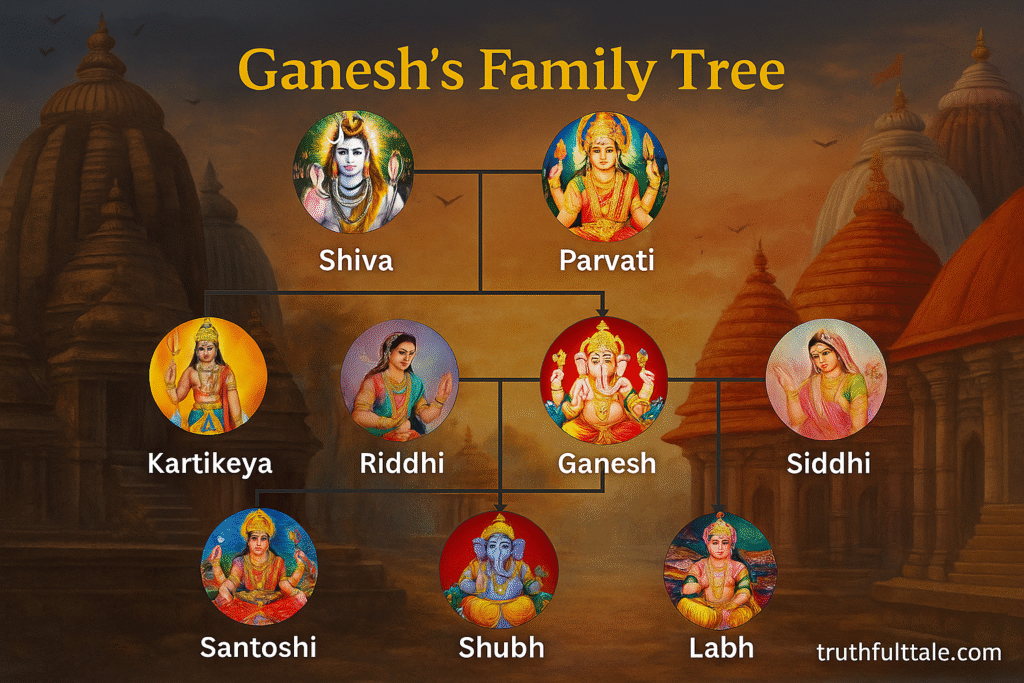Family of Lord Ganesha

Lord Ganesha, the beloved remover of obstacles, is not only worshipped for his wisdom and blessings but also holds a very special place in Hindu mythology as a part of a divine family. His family ties are deeply symbolic and carry important spiritual lessons.
The Birth of Lord Ganesha
According to the Shiva Purana, Goddess Parvati created Ganesha out of sandalwood paste to guard her while she bathed. When Lord Shiva tried to enter, the boy stopped him, not knowing who he was. Angered, Shiva cut off Ganesha’s head. Seeing this, Parvati was heartbroken and demanded her son be revived. To console her, Shiva restored Ganesha to life by placing the head of a powerful elephant on him and blessed him as his son. From that moment, Lord Ganesha was declared the remover of obstacles and the first deity to be worshipped before all others.
Lord Shiva – The Father
Lord Shiva, the Supreme God of destruction and transformation, is the father of Ganesha. According to Hindu belief, Ganesha was created by Goddess Parvati, but it was Lord Shiva who later accepted him as his son after the famous incident of beheading and reviving him with an elephant head. Shiva’s role in Ganesha’s life represents the eternal bond of fatherhood and divine protection.
Goddess Parvati – The Mother
Goddess Parvati, the consort of Lord Shiva, is the mother of Ganesha. She created him out of sandalwood paste and gave him life to guard her privacy. Parvati is often called Shakti (divine feminine power), and her bond with Ganesha shows the strength of maternal love and creation.
Kartikeya (Skanda/Murugan) – The Brother
Kartikeya, also known as Skanda or Murugan, is Ganesha’s elder brother. While Kartikeya is the commander of the divine army and symbolizes courage, valor, and victory, Ganesha represents wisdom and intellect. In many stories, their sibling rivalry and affection reflect the balance between strength and intelligence.
Riddhi and Siddhi – The Wives
According to mythology, Ganesha married Riddhi (prosperity) and Siddhi (spiritual power). Sometimes, Buddhi (intellect) is also mentioned as his consort. Their union symbolizes the idea that true success in life requires wisdom along with prosperity and spiritual fulfillment.
Shubh and Labh – The Sons
Ganesha and his wives Riddhi and Siddhi are believed to have two sons:
Shubh – Symbolizes auspiciousness and goodness.
Labh – Symbolizes profit and spiritual gain.
Together, they complete the divine cycle of prosperity, wisdom, and auspiciousness.
Ashokasundari – The Sister
In some Puranic texts, Ganesha also has a sister named Ashokasundari, the daughter of Shiva and Parvati. Though not widely worshipped, she is considered part of the extended family, symbolizing beauty, happiness, and relief from sorrow.
Santoshi Maa – The Daughter (Folk Belief)
In popular folk tradition, especially after the 1975 film Jai Santoshi Maa, Ganesha is also believed to have a daughter named Santoshi Maa. Born to fulfill the wish of Ganesha’s sons Shubh and Labh for a sister, she represents contentment and satisfaction. Devotees worship her, especially on Fridays, for peace and happiness in family life.
The Vehicle – Mushak (Mouse)
Ganesha’s vahana (vehicle), the mouse, is also considered part of his symbolic family. The mouse represents desire and ego, which Ganesha controls, teaching us the importance of mastering one’s impulses.
Disclaimer
This article is based on stories from Hindu scriptures such as the Shiva Purana, Skanda Purana, and Brahma Vaivarta Purana, along with popular folk traditions. Variations of these stories exist in different regions and communities. The content is shared for educational and cultural purposes, with deep respect for all beliefs.
The family of Lord Ganesha is not just a divine lineage but a representation of life’s balance — wisdom, strength, prosperity, devotion, and love. Each relationship of Ganesha holds a deeper meaning, guiding devotees toward a complete and fulfilling life.
👉 Stay connected with Truthfultale.com for more stories of faith, culture, and spirituality.
